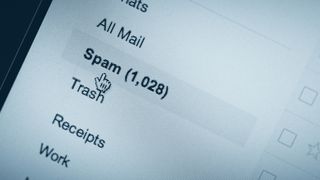Spam emails are wasting hundreds of work hours every year
Productivity is also being hit by spam

Spam email messages might be perceived as nothing more than a nuisance, but they’re actually hurting people’s productivity quite a lot, according to a Kaspersky report showing people can lose up to 80 hours a year just scrolling through, or filtering out, spam messages.
Citing a report on Security Boulevard, the company says anywhere between 45% and 85% of all emails generated every day is actual spam (including emails carrying malware and other malicious files).
But not all employees receive the same amount of spam messages, nor do they address them in the same way. Those that receive up to 30 external emails a day, also receive around 30 spam messages every week. It takes them roughly five hours a year to sort these messages out.
Share your thoughts on Cybersecurity and get a free copy of the Hacker's Manual 2022. Help us find how businesses are preparing for the post-Covid world and the implications of these activities on their cybersecurity plans. Enter your email at the end of this survey to get the bookazine, worth $10.99/£10.99.
Law of large numbers
Those getting between 30 and 60 external emails a day usually spend roughly 11 hours a year on the same task, while those on the receiving end of up to 100 emails a day spend as much as 18 hours - more than two full days - sorting these messages in their inboxes.
Finally, those that receive more than 100 messages every day usually need around 80 hours a year to clean up their inboxes.
For Andrey Kovtun, Email Threats Protection Group Manager at Kaspersky, five hours in a year might not sound like much, but there are hidden dangers that should not be dropped out of sight.
“When scaled to an organization with hundreds of employees, this may turn into a sizable amount of person-hours. The number may look greater in businesses focused on providing services where employees communicate more actively with external parties,” he said.
Are you a pro? Subscribe to our newsletter
Sign up to the TechRadar Pro newsletter to get all the top news, opinion, features and guidance your business needs to succeed!
Kovtun also added that returning to work after reading and deleting spam messages takes a little time as well, mostly because people get distracted.
“These negative effects of spam may not be so obvious, but organizations should be aware of them and protect their employees with dedicated anti-spam and anti-phishing tools.”
Besides the obvious move of having anti-spam and junk email functions enabled in the email service, businesses should also educate employees to recognize spam messages, as well as implement dedicated email protection services.
Sead is a seasoned freelance journalist based in Sarajevo, Bosnia and Herzegovina. He writes about IT (cloud, IoT, 5G, VPN) and cybersecurity (ransomware, data breaches, laws and regulations). In his career, spanning more than a decade, he’s written for numerous media outlets, including Al Jazeera Balkans. He’s also held several modules on content writing for Represent Communications.


